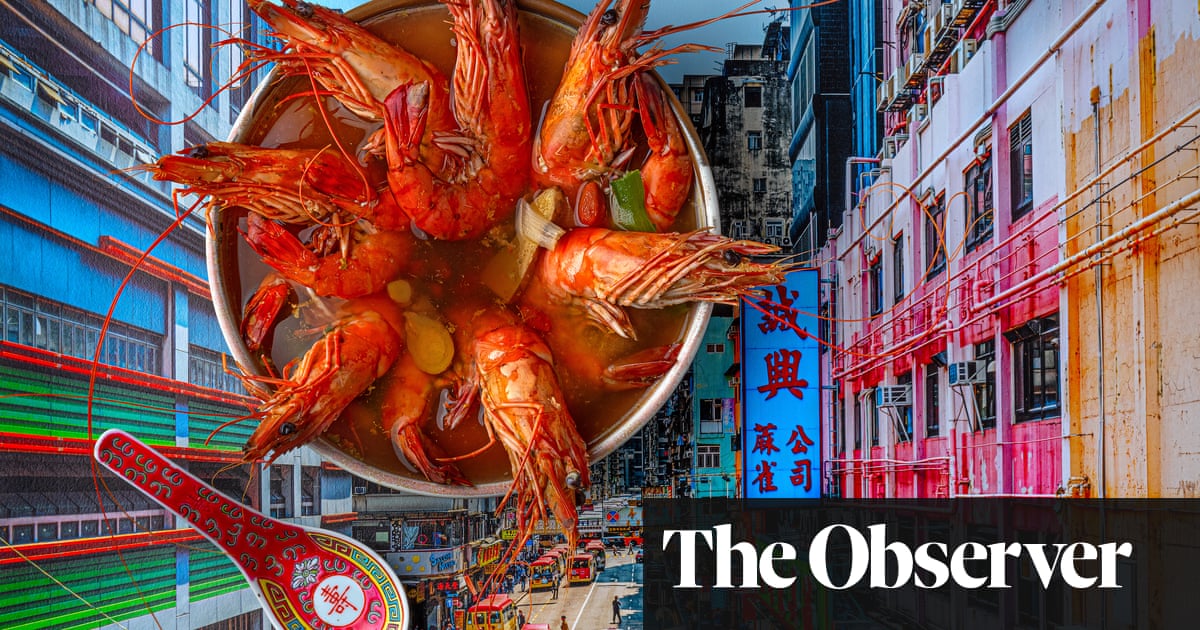
Fresh corn on the cob
Pamela Brunton, chef and co-owner, Inver, Argyll
My mum grew corn on the cob on the east coast of Scotland. It’s sunnier than the west coast, but it’s still cold thanks to the North Sea. Nevertheless, Mum grew corn, and we loved eating it straight, fresh with loads of butter, and salt to dip it in. Now that I’m older I understand the emotional implications of this. Mum grew up in Zimbabwe, where corn was a staple, eaten fresh or ground into mealy pap. We have cine films of her and my uncle playing between corn plants, throwing leaves. She came back in her early teens, and her parents died in a plane crash – in the plane that was bringing them back after her, so there’s this huge rupture in our family history. The corn Mum grew was the narrative that connected us with her history and memories, which I have no other way of knowing than through cine films. It taught me how food can tell stories; how familiar flavours, done differently, can evoke places and people on a plate. Now, for the first time, our gardener is growing corn at Inver, which we will hopefully serve in the restaurant.
A pint of prawns with lemon and mayonnaise
Roberta Hall-McCarron, chef and co-founder, Elinore and the Little Chartroom, Edinburgh
My dad has always had sailing boats – Elinore is the name of one of them – and during the holidays we would set sail around the west coast of Scotland. We’d anchor, get in the dinghy and head to a coastal pub, where we’d eat pints of prawns with lemon and mayonnaise. We were with our family and friends, having a good time, and that is something I still believe food should do: bring people together, make them happy and relaxed. At our restaurants, I want to recreate the experience of those holidays; not the exact food, but the togetherness. Years ago, Mum chopped up some of Dad’s old shipping charts, and made them into art which hangs on the wall of the Little Chartroom – hence the name. Though we don’t serve pints of prawns here, we serve lots of shellfish, and we never do too much to it; for example, we have a plaice dish with langoustines which we gently confit in an oil made out of their shells. Those childhood sailing holidays have resonated throughout my career.
Samosas
Ravinder Bhogal, chef-owner, Jikoni, London
Cooking samosas took many hands; about 20 aunties would clip clop into our house in their sandals at 10am, and start rolling the dough and making the fillings. I remember as a young girl, lying under the table and listening to their chatter. I was lonely as a child, and being with these women who let me have a go rolling the samosas was comforting. I learned as if by osmosis the order of the spices and how to dry roast them, whether to grind them or use them whole. Just being there, surrounded by those women, you inherit that knowledge and my nose has been trained to know when a spice mixture is ready. My restaurant is shaped by this maternal style of cooking; intuitive, wasting nothing and preserving those techniques that have been passed down through generations of women. Today it is a pride and a pleasure to represent those women who are so marginalised on the London restaurant scene.
Shanghai shrimps in vinegar
Jeremy Chan, head chef and co-founder, Ikoyi, London
I like Chinese restaurants. I like their speed and efficiency, and the way the service is about encouraging interaction between guests, rather than making a show of connecting with them. I love hospitality and want my guests to have a good time, but I don’t want to be seen. I think part of that comes from growing up in Hong Kong, where service is more restrained. When I was about six or seven, we went to a Cantonese restaurant. We had so many dishes all at once: chicken feet, roast duck, dumplings, jellyfish – a bombardment of ingredients, but the dish that stood out most was the drunken shrimp. They were brown and curled up, sweet and nutty but with a sharp kick of ginger. They came in a bowl with a spoon, so you could eat them like cereal, which felt indulgent and refreshing. I remember the texture most of all: the ginger sweet glaze, the bounciness of the shrimp. It was a simple dish, but unusual and texturally complex; it’s a texture I always think of when I cook seafood today. I often think back to that dish, and that restaurant, and my memory – not just that of texture and taste but an overall feeling.
Grandmother’s bunny chow
Nokx Majozi, senior chef and head pie maker, Holborn Dining Rooms
All the kids in our village looked forward to my grandma’s bunny chow. We all played together, and each lunchtime we went to a different grandma’s house to eat. Some cooked more traditional food, some more European food – we had our favourites and our less-favourites, and we learned to appreciate the differences. They’d shout when it was time for lunch, and because it was the countryside we could hear them from miles away. Bunny chow is traditional in South Africa: it’s a homemade bread, cut in half, with the soft inside removed and filled with lamb curry. When you break the bread, the sauce and the meat tumble out; sharing that with friends is magical. Grandma would start with the young ones, then feed the older ones, and we were family over food. I liked that we knew what we were going to have from each grandma, and today I like that people come to Holborn Dining Rooms and know what they are going to have. We serve comforting food, and people understand it.
Lemon meringue pie
Stephen Harris, chef-owner, The Sportsman, Seasalter, Kent
My heart sinks when a waiter says: “Now for dessert, celery ice-cream.” I’m quite simple when it comes to pudding, and I love a classic combination. My favourite growing up was lemon meringue pie: it was what I’d always ask Mum to make on my birthday and though I didn’t make the connection until years later, it was a lemon tart I had at Chez Nico that made me want to be a chef. That tart was so perfect. I’d never been to a Michelin-star restaurant before but, as a keen amateur, I knew how difficult perfection is. This was a thick wedge that wobbled and looked like it had to fall over; it was the perfect tart case, and the perfect slow set. It was a Proustian moment – not that my mum’s lemon meringue pie was Michelin standard, but it’s that emotional thing, isn’t it? It had lovely pastry with a tangy filling. We’ve not had lemon meringue pie on the menu but we often serve lemon tart in winter, when there’s not much fresh fruit around. It’s what I want at the end of a meal; refreshing, slightly bitter or sharp, but sweet.
Ritz crackers crab dip
Santiago Lastra, chef and co-owner, Kol, London
At 15, I wanted to be everything. I wanted to be a basketball player, a mathematician, a musician, an artist, a hotelier. One day I picked up a pack of Ritz crackers in the supermarket, and on the back I saw a recipe for crab dip. I decided not to go out that night and use the money to buy the ingredients and make it for my brother and mum. They liked it, and it made me happy to please them – so I made it again, and again. It was a turning point, seeing how one dish transformed a normal evening. I made meatballs, pasta and bread – each one felt like an achievement. I thought, “I want to do this for the rest of my life” – to contribute to people’s happiness, even if just for a night. I love that moment when the dish comes to the table, and your guests look at each other and smile. A song doesn’t belong to the musician; people make it their own and enjoy it, and that’s what great dishes do. It’s a hard profession, being a chef, but it’s worth it to curate happy moments for people. And it started with the box of crackers – which my mum has since framed, and hung on the wall.
Wild salmon with brown bread
Richard Corrigan, chef and restaurateur, The Portrait and Corrigan’s Mayfair, London
My father used to say to me, you can smell wild salmon, and he was right. It’s something special. There are only a few left now – that’s what happens when you trawl the seas and dump chemicals in the water – but when I was a child in County Meath in Ireland, wild salmon served with salty homemade butter and brown bread for breakfast was not unknown. My mother baked, my father shot and fished, and breakfast, lunch and dinner all came from the land and the rivers. Having that natural basket has informed my no-nonsense approach to food. The bread has to be freshly made, the crust has to be just cooling down – you don’t want it hot – and the salmon cooked in a cast-iron pan with the skin on. You don’t need lemon, you don’t need anything, just the untouched natural beauty of the magnificent salmon, and butter melting into bread under a crispy skin. We didn’t have much cash, but we ate like kings.
Sri Lankan sardines with laksa
Cynthia Shanmugalingam, founder, Rambutan, London
When I was about 10, I remember my dad saying : “Don’t say anything in Tamil on the bus, just keep your mouth shut.” We were travelling through the southern part of Sri Lanka, on one of our annual trips back. I was born in Coventry, and those trips were like windows on a different world. That year, the war had become worse. Mum wasn’t interested in going, but Dad was more adventurous and would take us on these mad journeys cross-country. On this occasion we went all the way to the belly of the south, where my mum’s cousin lived in a tiny, ramshackle house. We were hungry when we arrived, so she suggested we go to the sea. There the shore was lined with boats, each one lit up with a fire torch, and fishermen were selling their daily catch under the stars. We had Sri Lankan sardines, which I’d never had before, and when we got back she doused them in a simple mix of roasted chillies, coriander and fenugreek, then deep fried them. She made string hoppers, and a laksa with coconut milk, onions, curry leaves and lime juice. I’d only eaten fish from the supermarket, so it opened my eyes to how delicious fish can be. It’s also the first time I remember textures clearly; the oiliness of the sardines, the crispness of the fried fish with the noodles, the sauce. Her kitchen was the most basic I’d ever seen. It’s shaped my philosophy that there is a beauty in getting the basics right. Sri Lanka always felt like a place where colours are brighter and senses are sharpened.











